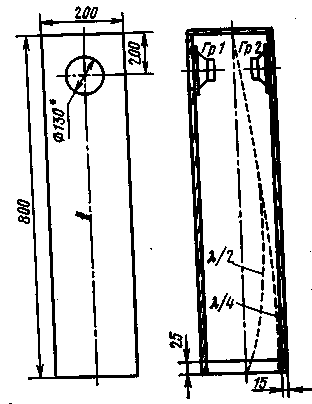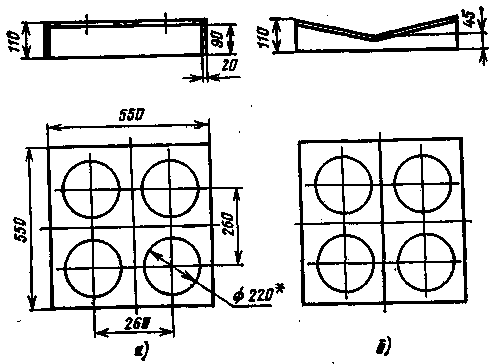
|
|
ENCYCLOPEDIA OF RADIO ELECTRONICS AND ELECTRICAL ENGINEERING Acoustic design of wideband heads. Encyclopedia of radio electronics and electrical engineering
Encyclopedia of radio electronics and electrical engineering / Speakers The acoustic design of dynamic heads consists of a box or screen designed to equalize the amplitude-frequency characteristics of the heads in the lower frequencies of the audio range. Dynamic heads that do not have acoustic design work poorly at low frequencies. The main reason for this is that the front and back surfaces of the head cone excite sound vibrations that are equal in amplitude but opposite in phase. At lower frequencies, where the radiation is omnidirectional, the antiphase oscillations add up and compensate each other, as a result of which the acoustic output of the head drops sharply. To eliminate the mutual influence of vibrations excited by the front rear surfaces of the diffuser, the dynamic head can be placed in the simplest case in the center of a square screen made of thick plywood or chipboard with dimensions LxL in meters, where L = 0,06 / Fmin. Here Fmin is the minimum frequency of the reproduced signal, kHz. For example, with a minimum signal frequency of 50 Hz, this formula determines the side of the square, equal to 1,2 m. Obviously, it is inconvenient to use a wideband head in such a bulky acoustic design. Therefore, acoustic baffles are rare in amateur designs. Instead, various multifaceted boxes are widely used. boxes with and without a back wall. It should be noted that the design of the acoustic design of dynamic heads requires complex calculations and accurate information about the characteristics of the head. Consideration of these issues is beyond the scope of this book. Below we will consider examples of how foreign radio amateurs carry out acoustic design of wideband heads. Ultra flat bass reflex Phase inverters are boxes made of thick plywood or other similar wood material (pine boards, chipboards), in which there are two holes. One - for installing a dynamic head, the other - for acoustic communication between the internal volume of the box and the external environment. When selecting certain ratios between the dimensions of the head diffuser, the second hole and the box itself, taking into account the frequency properties of the head, it is possible to ensure that at lower frequencies the vibrations excited by the rear surface of the head diffuser at the output of the second hole of the phase inverter will be in phase with the vibrations excited by the front surface diffuser. This remarkable property of a phase inverter has long been widely used in amateur and professional installations. The phase inverter has one drawback - the bulkiness of the box, which is close in shape to a cube. In this regard, the design of an ultra-flat phase inverter deserves attention. The design drawing is shown in Fig.1.
As follows from the description of the original, the case of the phase inverter box is assembled from dry pine boards or pieces of chipboard about 20 mm thick. Overall dimensions of the case 150X1580X630 mm. The housing is designed to install a broadband dynamic head, similar to the domestic head of the 4GD-35 or 4GD-36 type. The phase inverter hole has dimensions of 50x125 mm and is located under the head hole. The diffuser holder of the head is fixed on the outside, flush, which reduces losses at all frequencies. To eliminate unwanted oscillations of the front and rear surfaces of the housing, there are five spacers, indicated in the drawing in Fig. 1 by dashed showers, which connect the front and rear walls. Spacers measuring 20X109X200 mm are made from the same material as the box body. Connect the body parts with screws and nitro glue. The exterior finish of the case is reduced to draping the front panel with radio fabric, preferably loose, and pasting the walls with a decorative film or veneering them. The phase inverter fits well into the interior of a modern room and can be placed directly against the wall. For a stereo setup, two speakers are required. When repeating the design, the dimensions of the mounting holes for a particular type of dynamic head should be clarified. In addition to the above, it is possible to use heads like 4GD-4, 4GD-7, 4GD-28. Loudspeaker - organ pipe High demands on the quality of the acoustic installation, on the one hand, and the limited area of \u2b\uXNUMXbthe living room where loudspeakers can be placed, on the other, force designers to look for solutions that meet these requirements, or find an acceptable compromise. In this regard, the design of a single-way loudspeaker with two broadband dynamic heads connected in phase, in series, is of particular interest. The loudspeaker is described in American amateur radio literature. Sketches of its front panel and cross section are shown in Fig.XNUMX.
The described loudspeaker has a case in the form of a column with a cross section of 200x200 mm, a height of 800 mm, with two slots at the base, formed between the floor and side walls shortened by 26 mm, as shown in Fig. 2. In the upper part of the case there are two holes for installing dynamic heads on the front and rear walls of the case. The dimensions of the cutout and the characteristics of the heads make it possible to use domestic dynamic heads of the ZGD-38 type in this design. The walls of the case are made of plywood or chipboard with a thickness of about 15 mm. The elongated shape of the loudspeaker housing, the small floor area occupied by it, allow the use of such loudspeakers in stereo and quad installations. In addition, the loudspeaker of the described design is characterized by improved low-frequency response and an extended radiation pattern in the horizontal plane. The first advantage is due to the phenomenon of standing waves observed inside the loudspeaker cabinet, which behaves like an organ pipe tuned to a frequency of about 100 Hz. It is at this frequency that one quarter of the wave fits along the loudspeaker cabinet, which contributes to the rise of the lower frequencies. At a frequency twice as high, equal to 200 Hz, on the contrary, exactly half the wavelength fits along the length of the body. At the same time, suppression of radiation from the lower part of the body is observed, which eliminates the unpleasant mumbling overtones characteristic of acoustic installations with large linear dimensions. The second advantage is associated with the use of two heads emitting in opposite directions. By changing the direction of the radiation of the speakers by rotating them about the longitudinal axis, you can achieve the best sound reproduction in a particular room. In this case, one should not regret that half of the radiated power is directed in the opposite direction relative to the listener. The lower and middle frequencies, reflected from walls and furniture, give repeated re-emission of sound, as if blurring the small dimensions of the sound sources themselves and creating the impression of spatial sound. Loudspeaker - group radiator A group radiator is a set of the same type of dynamic heads placed in the same plane at a certain distance from each other and connected to each other in phase, in series or in parallel or in series-parallel. To ensure good performance of a group radiator type loudspeaker, it is necessary that all heads are of the same type and that the same power is supplied to each head. Failure to comply with these requirements or a violation of the common-mode operation of the heads reduces the efficiency of the group emitter. The widespread use of this type of loudspeakers abroad is due to several reasons. The first is that with the help of several heads of small power it is possible to create a loudspeaker of high power. So, in the Swedish amateur radio magazine, descriptions of amateur loudspeakers were published, containing up to 6-8 of the same type of broadband heads of 20 W each. Such loudspeakers can work with amplifiers having an output power of up to 100-200 watts. Another reason for the spread of group radiators is their inherent improvement in returns at medium and especially the lowest frequencies. This improvement is due to an increase in the opening area of the diffusers, proportional to the number of heads. At the lowest frequencies, this increase is 6dB for four heads, 8dB for six, and 9dB for eight. Due to this, the bandwidth of effectively reproducible frequencies is expanded to the region of lower frequencies by about a third or half an octave compared to the bandwidth of a single head in the same design. The third reason is that the depth of the case box of such a loudspeaker can be 1,5-2 times less than that of a loudspeaker with a single head, i.e., the group radiator can be quite flat and can be placed on the floor near the wall or even hung on wall. Let us dwell on two variants of the design of a loudspeaker of the group radiator type, containing four dynamic heads of 6 W each. In these loudspeakers, it is most convenient to use low-frequency heads of the 6GD-2 type. With a decrease in the diameters of the holes, it is possible to use heads of the type 4GD-4 or 4GD-7, 4GD-av. 4GD-35, 4GD-36. Preference should be given to the first and last two heads.
The design of the housings of both variants is shown in Fig. 3, a, b. Cases are made of chipboard 20 mm thick. Details are assembled on screws and glue. The difference between the options lies in the shape of the front wall: in fig. 3, and it is flat, in Fig. 3,6 - slightly folded in the middle. Both designs have approximately the same characteristics in the low-frequency region. The results of the calculations carried out by the author are shown in Fig. 4, from which it can be seen that a noticeable increase in the recoil of the heads with a distance between the centers of their diffusers equal to 260 mm is observed starting from a signal frequency below 600 Hz.
The main advantage of a loudspeaker with a broken front panel (Fig. 3b) is a somewhat better radiation uniformity at medium and high frequencies in both planes. For a loudspeaker with a flat front panel (Fig. 3a), on the contrary, the radiation pattern narrows at these frequencies. Group radiators have been widely used recently, they are often used as low-frequency radiators for systems with several signal frequency separation bands. Such systems, designed for input power up to 50-100 W or more, are widely used for sounding stage, dance halls and discos. Literature:
Publication: N. Bolshakov, rf.atnn.ru
Artificial leather for touch emulation
15.04.2024 Petgugu Global cat litter
15.04.2024 The attractiveness of caring men
14.04.2024
▪ Logitech Pop smart home controller ▪ The bus recognizes the pedestrian
▪ section of the site Electronic directories. Article selection ▪ article Bonfires and hearths. Basics of safe life ▪ article What is silicon? Detailed answer ▪ article Information Security Engineer. Job description
Home page | Library | Articles | Website map | Site Reviews www.diagram.com.ua |






 Arabic
Arabic Bengali
Bengali Chinese
Chinese English
English French
French German
German Hebrew
Hebrew Hindi
Hindi Italian
Italian Japanese
Japanese Korean
Korean Malay
Malay Polish
Polish Portuguese
Portuguese Spanish
Spanish Turkish
Turkish Ukrainian
Ukrainian Vietnamese
Vietnamese




 Leave your comment on this article:
Leave your comment on this article: